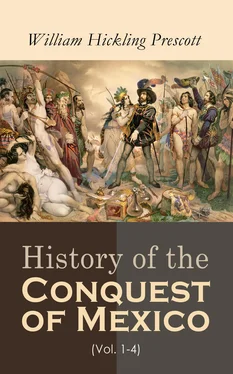The chronological system of the Mexicans, by which they determined the date of any particular event, was also very remarkable. The epoch from which they reckoned corresponded with the year 1091 of the Christian era. It was the period of the reform of their calendar, soon after their migration from Aztlan. They threw the years, as already noticed, into great cycles, of fifty-two each, which they called “sheafs,” or “bundles,” and represented by a quantity of reeds bound together by a string. As often as this hieroglyphic occurs in their maps, it shows the number of half-centuries. To enable them to specify any particular year, they divided the great cycle into four smaller cycles, or indictions, of thirteen years each. They then adopted two periodical series of signs, one consisting of their numerical dots, up to thirteen, the other, of four hieroglyphics of the years. [188]These latter they repeated in regular succession, setting against each one a number of the corresponding series of dots, continued also in regular succession up to thirteen. The same system was pursued through the four indictions, which thus, it will be observed, began always with a different hieroglyphic of the year from the preceding; and in this way each of the hieroglyphics was made to combine successively with each of the numerical signs, but never twice with the same; since four, and thirteen, the factors of fifty-two,—the number of years in the cycle,—must admit of just as many combinations as are equal to their product. Thus every year had its appropriate symbol, by which it was at once recognized. And this symbol, preceded by the proper number of “bundles” indicating the half-centuries, showed the precise time which had elapsed since the national epoch of 1091. [189]The ingenious contrivance of a periodical series, in place of the cumbrous system of hieroglyphical notation, is not peculiar to the Aztecs, and is to be found among various nations on the Asiatic continent,—the same in principle, though varying materially in arrangement. [190]
The solar calendar above described might have answered all the purposes of the people; but the priests chose to construct another for themselves. This was called a “lunar reckoning,” though nowise accommodated to the revolutions of the moon. [191]It was formed, also, of two periodical series, one of them consisting of thirteen numerical signs, or dots, the other, of the twenty hieroglyphics of the days. But, as the product of these combinations would be only 260, and as some confusion might arise from the repetition of the same terms for the remaining 105 days of the year, they invented a third series, consisting of nine additional hieroglyphics, which, alternating with the two preceding series, rendered it impossible that the three should coincide twice in the same year, or indeed in less than 2340 days; since 20 × 13 × 9 = 2340. [192]Thirteen was a mystic number, of frequent use in their tables. [193]Why they resorted to that of nine, on this occasion, is not so clear. [194]
This second calendar rouses a holy indignation in the early Spanish missionaries, and Father Sahagun loudly condemns it, as “most unhallowed, since it is founded neither on natural reason, nor on the influence of the planets, nor on the true course of the year; but is plainly the work of necromancy, and the fruit of a compact with the Devil!” [195]One may doubt whether the superstition of those who invented the scheme was greater than that of those who thus impugned it. At all events, we may, without having recourse to supernatural agency, find in the human heart a sufficient explanation of its origin; in that love of power, that has led the priesthood of many a faith to affect a mystery the key to which was in their own keeping.
By means of this calendar, the Aztec priests kept their own records, regulated the festivals and seasons of sacrifice, and made all their astrological calculations. [196]The false science of astrology is natural to a state of society partially civilized, where the mind, impatient of the slow and cautious examination by which alone it can arrive at truth, launches at once into the regions of speculation, and rashly attempts to lift the veil—the impenetrable veil—which is drawn around the mysteries of nature. It is the characteristic of true science to discern the impassable, but not very obvious, limits which divide the province of reason from that of speculation. Such knowledge comes tardily. How many ages have rolled away, in which powers that, rightly directed, might have revealed the great laws of nature, have been wasted in brilliant but barren reveries on alchemy and astrology!
The latter is more particularly the study of a primitive age; when the mind, incapable of arriving at the stupendous fact that the myriads of minute lights glowing in the firmament are the centres of systems as glorious as our own, is naturally led to speculate on their probable uses, and to connect them in some way or other with man, for whose convenience every other object in the universe seems to have been created. As the eye of the simple child of nature watches, through the long nights, the stately march of the heavenly bodies, and sees the bright hosts coming up, one after another, and changing with the changing seasons of the year, he naturally associates them with those seasons, as the periods over which they hold a mysterious influence. In the same manner, he connects their appearance with any interesting event of the time, and explores, in their flaming characters, the destinies of the new-born infant. [197]Such is the origin of astrology, the false lights of which have continued from the earliest ages to dazzle and bewilder mankind, till they have faded away in the superior illumination of a comparatively recent period.
The astrological scheme of the Aztecs was founded less on the planetary influences than on those of the arbitrary signs they had adopted for the months and days. The character of the leading sign in each lunar cycle of thirteen days gave a complexion to the whole; though this was qualified in some degree by the signs of the succeeding days, as well as by those of the hours. It was in adjusting these conflicting forces that the great art of the diviner was shown. In no country, not even in ancient Egypt, were the dreams of the astrologer more implicitly deferred to. On the birth of a child, he was instantly summoned. The time of the event was accurately ascertained; and the family hung in trembling suspense, as the minister of Heaven cast the horoscope of the infant and unrolled the dark volume of destiny. The influence of the priest was confessed by the Mexican in the very first breath which he inhaled. [198]
We know little further of the astronomical attainments of the Aztecs. That they were acquainted with the cause of eclipses is evident from the representation, on their maps, of the disk of the moon projected on that of the sun. [199]Whether they had arranged a system of constellations is uncertain; though that they recognized some of the most obvious, as the Pleiades, for example, is evident from the fact that they regulated their festivals by them. We know of no astronomical instruments used by them, except the dial. [200]An immense circular block of carved stone, disinterred in 1790, in the great square of Mexico, has supplied an acute and learned scholar with the means of establishing some interesting facts in regard to Mexican science. [201]This colossal fragment, on which the calendar [202]is engraved, shows that they had the means of settling the hours of the day with precision, the periods of the solstices and of the equinoxes, and that of the transit of the sun across the zenith of Mexico. [203]
We cannot contemplate the astronomical science of the Mexicans, so disproportioned to their progress in other walks of civilization, without astonishment. An acquaintance with some of the more obvious principles of astronomy is within the reach of the rudest people. With a little care, they may learn to connect the regular changes of the seasons with those of the place of the sun at his rising and setting. They may follow the march of the great luminary through the heavens, by watching the stars that first brighten on his evening track or fade in his morning beams. They may measure a revolution of the moon, by marking her phases, and may even form a general idea of the number of such revolutions in a solar year. But that they should be capable of accurately adjusting their festivals by the movements of the heavenly bodies, and should fix the true length of the tropical year, with a precision unknown to the great philosophers of antiquity, could be the result only of a long series of nice and patient observations, evincing no slight progress in civilization. [204]But whence could the rude inhabitants of these mountain-regions have derived this curious erudition? Not from the barbarous hordes who roamed over the higher latitudes of the North; nor from the more polished races on the Southern continent, with whom, it is apparent, they had no intercourse. If we are driven, in our embarrassment, like the greatest astronomer of our age, to seek the solution among the civilized communities of Asia, we shall still be perplexed by finding, amidst general resemblance of outline, sufficient discrepancy in the details to vindicate, in the judgments of many, the Aztec claim to originality. [205]
Читать дальше












